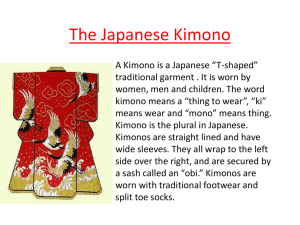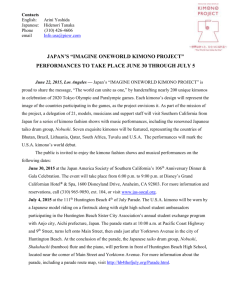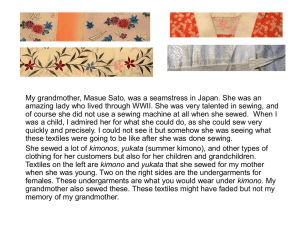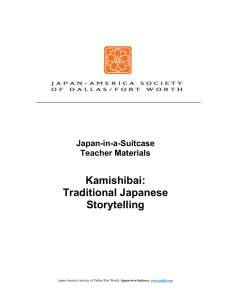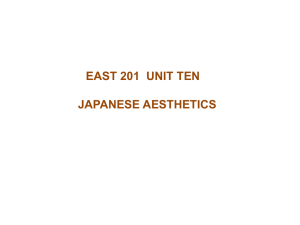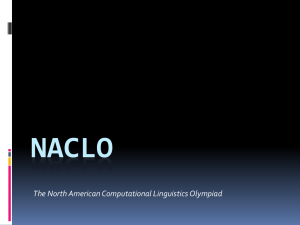Pattern
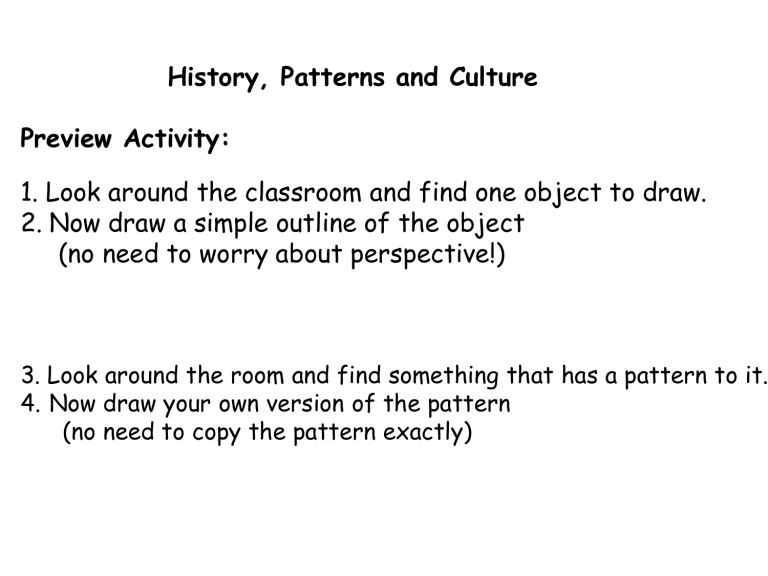
History, Patterns and Culture
Preview Activity:
1. Look around the classroom and find one object to draw.
2. Now draw a simple outline of the object
(no need to worry about perspective!)
3. Look around the room and find something that has a pattern to it.
4. Now draw your own version of the pattern
(no need to copy the pattern exactly)
Black Line Drawings and Patterns
Pattern (noun)
1. The way in which the elements of something are arranged (such as a work of art)
2. A unit of decoration that is repeated all over something
Cave Painting
What is Cave Painting?
• Refers to drawing, stencil art and painting on the walls and ceilings of prehistoric caves
• Stone Age (Paleolithic Era).
• Earliest form of mural painting , it is also called
"parietal art".
• Earliest art in prehistoric caves Chauvet Cave, in
France
• discovered in 1994, and date from 30,000 BCE.
Black Line Drawing and Patterns
Kente Cloth - Historical Background:
• Kente developed in the 17th Century A.D. by the Ashanti people (modern day Ghana)
• Roots come from a long tradition of weaving in Africa dating back to about 3000 B.C.E.
Kente Cloth-continued
:
• Legend has it that two learned the art of weaving by observing a spider weaving its web.
• Taking a cue from the spider, they wove a strip of into a pattern
• The Ashanti People adopted it as a royal cloth
Guatemalan Huipils: o Huipil (pronounced wee-peel) is the Spanish word for the traditional blouses worn by Mayan women for many centuries. o Clothing is of great cultural significance to the Maya o The huipil is the most important part of a woman’s traditional dress.
Huipils-continued: o The weave or design identifies individual personality o and village , marital, social, wealth, and religious status. o The patterns and meanings - remained since the ancient Maya civilization. o Huipils - both for everyday and ceremonial purposes or special occasions.
The Pomo Indians and Basketry: o The Pomo, an indigenous Native American tribe, resides in
Northern California on 70 acres of land in Redwood Valley.
o Originally, the tribe ran all along the Pacific Coast
Pomo Baskets and their uses:
• grinding acorns
• Fish trap: One basket is inside of another. The inner basket has a hole in the center. The fish swim in the first and get caught in the second basket.
More Pomo Basketry and their patterns:
• A coiled gift basket with feathers woven into it.
Native American Basket and Rug Patterns
Japanese Kimonos:
• The word "kimono", which literally means a "thing to wear“
• Traditional garment worn by men, women and children.
• Earliest kimonos were heavily influenced by traditional Han Chinese clothing (cultural diffusion)
• Professional sumo wrestlers are required to wear traditional Japanese kimonos when appearing in public.
More about Japanese Kimonos:
• The kimono is traditionally made of silk
• The pattern of the kimono
• determines the season it should be worn.
• For example:
• Spring butterflies or cherry blossoms
• Summer - Watery designs
• Autumn leaves of the Japanese maple tree
• Winter bamboo , pine trees and plum blossoms .
More about Japanese Kimonos:
• Old kimonos are often recycled and used to patch other kimonos, purses, make-up cases, pillows, etc.
• A woman's kimono may easily exceed $10,000
• a complete kimono outfit, with kimono, undergarments, obi, ties, socks, sandals, and accessories, can exceed $20,000
Patterns in Nature o
Take a moment to think about items you can find in nature which have a natural pattern.
o Make a list of at least 5 things: o Choose one of the items on your list and draw a simple version of the pattern which is present in the object
(remember you are drawing the pattern, not the object!)
Patterns in Nature
Japanese Kimono Designs
Pattern (noun)
1. The way in which the elements of something are arranged (such as a work of art)
2. A unit of decoration that is repeated all over something
Black Line Doodling and Designs
Now it’s your turn to be creative and design with doodles!
o Guernica, 1937 Pablo Picasso o Painted in response to the bombing in Guernica, Spain during WWII o Today the original is located in a museum in Madrid, Spain o There is also a tile replica of the painting in Guernica, Spain
